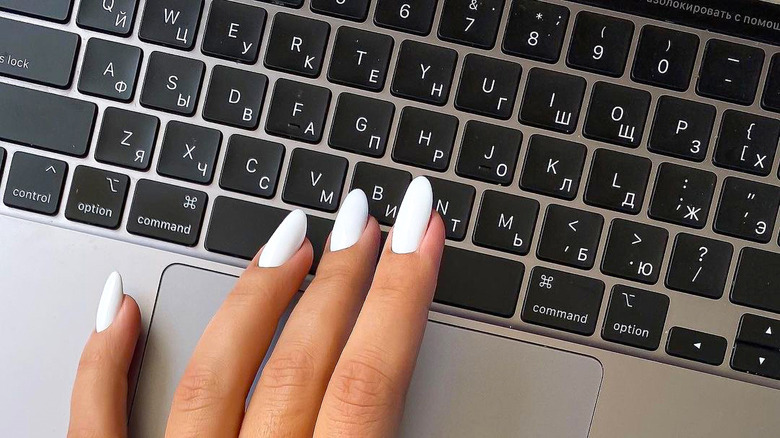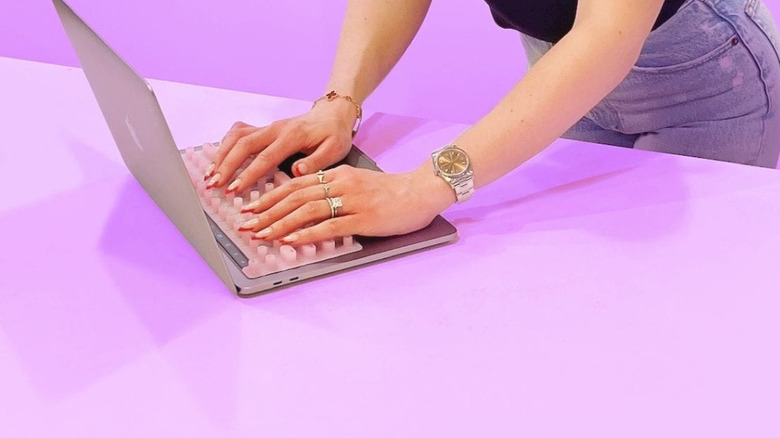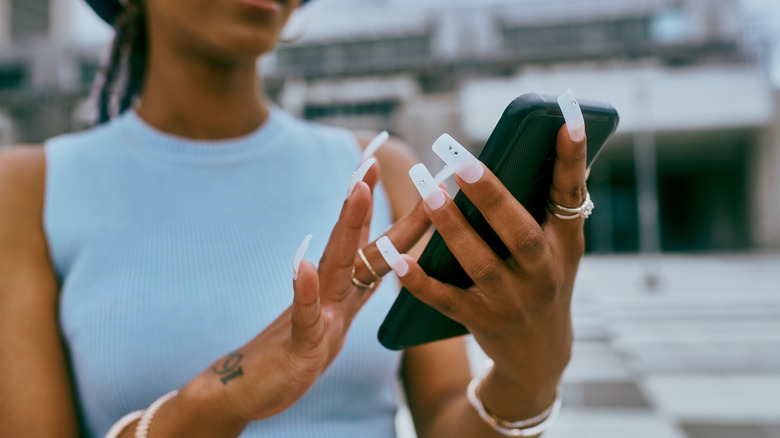How To Type With Long Nails (On A Phone And Laptop)
We may receive a commission on purchases made from links.
Long nails and technology typically don't mix. You can't quickly pull out your AirPods from the charging case, push the buttons on an ATM, or precisely plug in a flash drive into your computer, all because your nails are in the way. Typing on your phone or laptop can also become unnecessarily inconvenient. When you use your nails to type, you could end up with a scratched screen/keyboard, a broken nail, and plenty of typos. So instead of bending your fingers like you normally would, you need to lay them flat. This way, you can protect your screen/keyboard, reduce pressure on your nails, and hit the right keys.
The thing about typing with flat fingers, though, is the discomfort it can cause your hands over time. You're likely not used to typing this way, so you could easily suffer from muscle fatigue from keeping your fingers in the same rigid position for hours on end. Plus, you'll be sacrificing your typing speed. After all, it isn't natural or easy to press the keys while your fingers are extended, so you'll be typing slower than usual.
So, does this mean you have to live with short nails forever? Well, thanks to smart game-changing innovations, you can actually keep your fancy long nails and still be able to type on your phone or keyboard comfortably.
Tips for typing on a physical keyboard with long nails
Using a keyboard while having long nails is still pretty doable, thanks to the help of some productivity-boosting laptop accessories. One such accessory is the raised keyboard cover, like the tippy type and Majeree Keyboard Cover.
Usually made from silicone, raised keyboard covers come with thick, elevated keys to give your long nails the space they much need. This means even if you type with naturally curved fingers, it's your fingerpads that would touch the keys — not your long nails. Your nails just hover or go between the spaces without getting in contact. To use the raised keyboard cover, all you have to do is place it on top of your laptop's keyboard. Make sure to remove it before closing your laptop, though. Otherwise, it won't close all the way.
If you have an external mechanical keyboard that doesn't match any keyboard cover, you can also use raised keyboard stickers instead. They work the same as the raised keyboard cover, but you need to attach them individually to the keys. Some raised keyboard stickers are printed with letters, while others are plain and clear.
If you don't want to bother with stickers for your external keyboard, there's one nifty trick shared by TikTok user Allye Cruz you can try. Grab a book and put it under the bottom side of your keyboard to tilt it down. Then, add a wrist rest on top of the book to keep your wrist comfortable. Now, you can start typing even with your fingers bent. Your nails won't hit the keys since they're no longer pointed straight down.
Tips for typing on a phone with long nails
Unlike physical keyboards, you can't type on a smartphone with just your nails. Your taps simply won't register since nails aren't conductive like your fingers. To type on your phone with long nails, the trick is to either use your knuckles or find a position that lets you touch the screen with the tip or side of your fingers. This can mean holding the phone with both hands and then typing with both thumbs flat, or going the classic route with the phone on one hand and typing with a single finger on the other. Both methods can take some getting used to, though, so it might be a while before you can up your typing speed and accuracy.
If you find these positions uncomfortable or your nails are way too long for them, you can opt for a stylus instead. It could help you press the keys on your keyboard better. If your device supports it, you can even hand write your message with the stylus. Just write your message like how you would on paper and wait for the device to convert it to digital text. This works on Samsung phones and S Pens.
Another helpful tool is the built-in voice-to-text functionality or third-party transcription apps available on most phones. They translate the words you dictate into digital text. To enable this on iPhone, head over to Settings > General > Keyboard and toggle on Enable Dictation. A mic should then appear in the bottom-right corner of your onscreen keyboard. To activate voice-to-text on Android, install Gboard from the Play Store and press the mic icon in the upper right of the keyboard.
If all else fails, there's always voice messaging. Don't stress about typing — just record your message and hit send!


